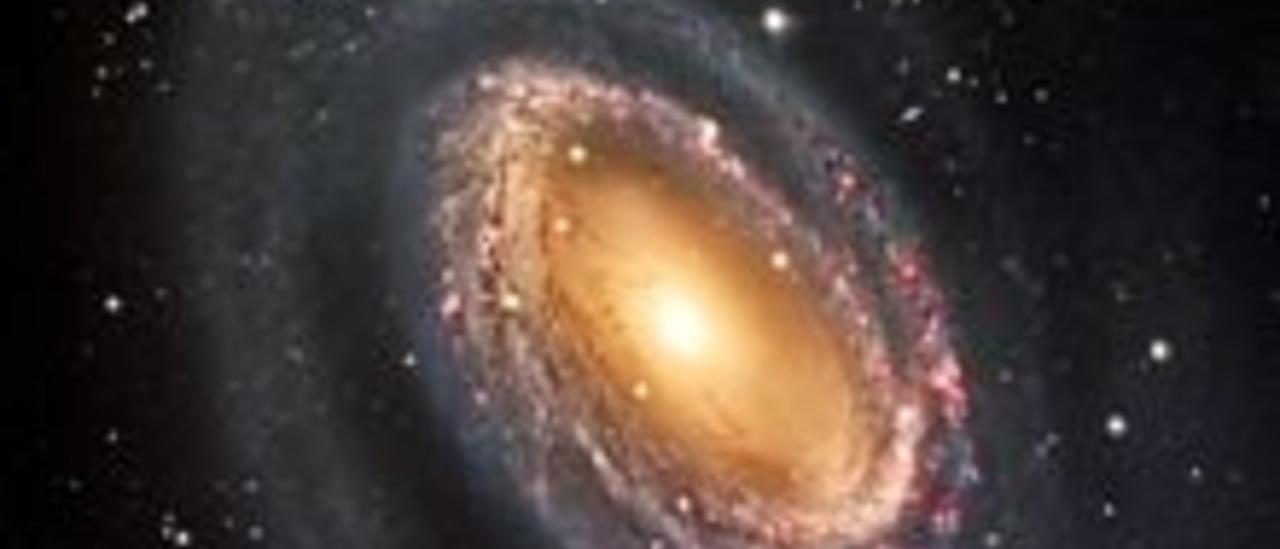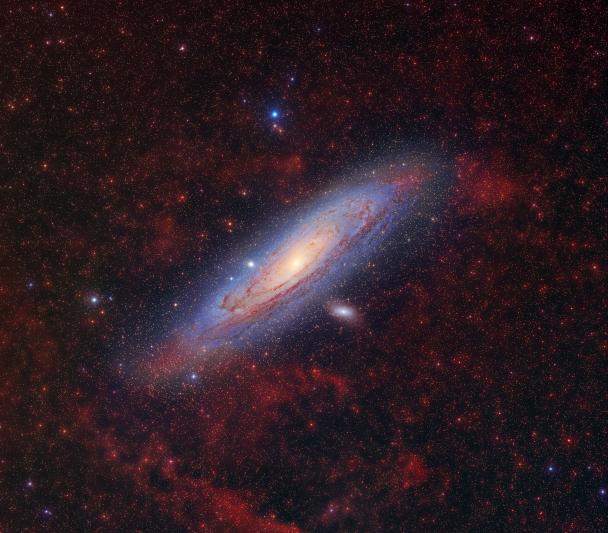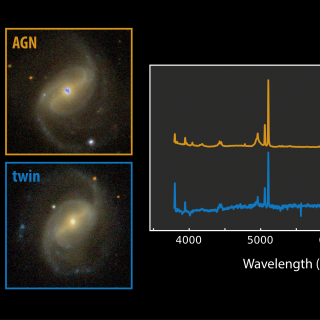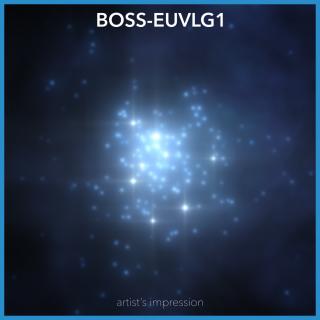General data
Galaxies have progressively formed through a complex combination of gas accretion, star formation, and merging with other galactic units. The Formation and Evolution of Galaxies research line aims to unveil the physical mechanisms responsible for the most significant transformations in these objects. The team that makes up the research line is strongly involved in the development of forefront instrumentation (FRIDA, GTCAO, HARMONI, WEAVE) and has an important role in the scientific exploitation and development of international projects (SDSS, EUCLID, LSST, WEAVE).
Specific goals 2020 - 2024:
- Identify the sources that reionized the universe one billion years after the Big Bang. Detect and study the first galaxies and quasars. Advance in our understanding of the nature and reality of dark matter. Investigate the low surface brightness universe to test dark matter predictions and galaxy formation theories.
- Study the physics of active galactic nuclei and supernovae feedback and their connection with galaxy evolution from the observational and theoretical point of view. Explore the multiwavelength nature of feedback and investigate its impact on the host galaxies using data from GTC/EMIR & FRIDA and ALMA. Run the largest hydrodynamical cosmological simulations to date by developing star formation and feedback prescriptions that are designed to work at low resolution.
- Study the physics of star formation and the conditions of the interstellar medium over the history of the Universe and under different physical conditions. Survey the star formation history, and the structural, kinematic and chemical properties of the various components of nearby galaxies to probe models of galaxy formation and evolution in a cosmological context. Get ready for resolved stellar population studies beyond what currently possible, exploiting future instruments on ELTs, JWST and other major facilities.
- Explore different gas accretion mechanisms necessary for galaxies to keep forming stars. Image from the first time Intergalactic Medium gas flows funnelling gas into local galaxies using GTC/MEGARA and WHT/WEAVE. Investigate the role of major/minor mergers and secular processes in galaxy evolution.
- Exploit unsupervised artificial intelligence to go beyond state-of-the-art data analysis techniques and get ready for big-data spectro-photometric surveys such as LSST, EUCLID, J-PAS and WFIRST.
- Improve the link between observations and theory by extracting and interpreting information from simulations of galaxies in a cosmological context spanning most of the Universe's life.
For previous specific goals visit: 2016-2019 IAC-SO website
Severo Ochoa Members
Coordinator
Research Lines Scientific Representative of the Severo Ochoa Programme at the IAC

Anna
Ferré Mateu
INVESTIGADOR/A PD RAMON Y CAJAL
Research Lines Scientific Representative of the Severo Ochoa Programme at the IAC

Helmut
Dannerbauer
CIENTÍFICO/A TITULAR OPIS
Staff
Advanced Fellow
Adriana de
Lorenzo-Cáceres Rodríguez
INVESTIGADOR/A PD RAMON Y CAJAL ULL
PhD Students
PhD Students
Pablo Manuel
Sánchez Alarcón
PredocFPI-20
PhD Students
Jorge Manuel
Sarrato Alós
PredocFPISO-21
Main scientific outputs
Scientific outputs 2020-2024:
- Galactic cirri in deep optical imaging. The ubiquitous presence of Galactic cirri in deep optical images represents a major obstacle to study the low surface brightness features of extragalactic sources. Using state-of-the-art, custom made, image processing techniques, including the modeling and removal of the instrumental scattered light produced by the stars, it has been possible to isolate the optical diffuse emission by the cirri, allowing their photometric characterization. The results show the high potential of deep multi-band optical photometry, on its own, identifying the presence of cirri at a higher spatial resolution than those provided by far-infrared observations. Román, Trujillo & Montes, 2020, A&A, 644, 42.
- The Galactic Activity, Torus and Outflow Survey (GATOS). I. ALMA images of dusty molecular tori in Seyfert galaxies. This work presents the first results of the Galaxy Activity, Torus, and Outflow Survey (GATOS), a project aimed at understanding the properties of the dusty molecular tori and their connection to the host galaxy in nearby Seyfert galaxies. The project expands the range of active galactic nuclei (AGN) luminosities and Eddington ratios covered by previous surveys of Seyferts conducted by the Atacama Large Millimeter Array (ALMA), with the aim of studying the gas feeding and feedback cycle in a combined sample of 19 Seyferts. The observations reveal for the first time supporting evidence that the imprint of AGN feedback is more extreme in higher luminosity and/or higher Eddington ratio Seyfert galaxies. García-Burillo, Alonso-Herrero, Ramos Almeida, et al. 2021, A&A, 652, 98.
- Sub-one per cent mass fractions of young stars in red massive galaxies. Elliptical and lenticular galaxies are the oldest and most massive galaxies in the Universe. These galaxies were built up rapidly (in less than thousand million years) and therefore, their stars are generally ancient and cool, meaning that they mainly shine in the optical and infrared spectral ranges. However, any hot young stars that might be present are difficult to detect in these spectral ranges. The study, based on 30,000 early-type galaxy spectra from the Sloan Digital Sky Survey BOSS has analysed the UV spectral range to detect the young stellar component of these galaxies, since the UV range is extremely sensitive to the presence of young stars. The results show that early-type galaxies are forming new stars at a very low rate, finding a small (0.5%) fraction of the stellar mass of these galaxies formed in the last 2 thousand million years. Salvador-Rusiñol, Vazdekis, La Barbera, et al. 2020, Nature Astronomy, 4, 252.
- Kinematic signatures of nuclear discs and bar-driven secular evolution in nearby galaxies of the MUSE TIMER project. The central regions of disc galaxies hold clues to the processes that dominate their formation and evolution. To exploit this, the TIMER project has obtained high signal-to-noise and spatial resolution integral-field spectroscopy data of the inner few kpc of 21 nearby massive barred galaxies, which allows studies of the stellar kinematics in their central regions with unprecedented spatial resolution. The results confirm theoretical predictions of the effects of bars on stellar kinematics and identify box/peanuts through kinematic signatures in mildly and moderately inclined galaxies, finding a lower limit to the fraction of massive barred galaxies with box/peanuts at ∼62%. Gadotti, Bittner, Falcón-Barroso, et al. 2020, A&A, 643, 14.
- Quasi-periodic behaviour in the optical and gamma-ray light curves of blazars 3C 66A and B2 1633+38. This work reports on quasi-periodic variability found in two blazars included in the Steward Observatory Blazar Monitoring data sample: the BL Lac object 3C 66A and the Flat Spectrum Radio Quasar B2 1633+38. This is the first reported evidence of quasi-periodic behaviour in the optical light curve of B2 1633+38. Also, a hint of quasi-periodic behaviour is found in the γ-ray light curve of B2 1633+38 with a confidence level ≥2σ, while no periodicity is observed for 3C 66A in this energy range. Otero-Santos, Acosta-Pulido, Becerra-González et al. 2020, MNRAS, 492, 5524.
- Pericentric passage-driven star formation in satellite galaxies and their hosts: CLUES from local group simulations. Local Group satellite galaxies show a wide diversity of star formation histories (SFHs) whose origin is yet to be fully understood. Using hydrodynamical simulations from the Constrained Local UniversE project, the authors study the SFHs of satellites of Milky Way-like galaxies in a cosmological context: while in the majority of the cases the accretion on to their host galaxy causes the satellites to lose their gas, with a subsequent suppression in star formation, in about 25 per cent of the sample there is a clear enhancement of star formation after infall. Di Cintio, Mostoghiu, Knebe, et al. 2021, MNRAS, 506, 531.
- Stellar masses of giant clumps in CANDELS and simulated galaxies using machine learning. A significant fraction of high redshift star-forming disc galaxies are known to host giant clumps, whose nature and role in galaxy evolution are yet to be understood. In this work, the authors present a new method based on neural networks to detect clumps in galaxy images. They use this method to detect clumps in rest-frame optical and UV images of a complete sample of ~1500 star forminggalaxies at 1 < z < 3 in the CANDELS survey as well as in images from the VELA zoom-in cosmological simulations. They show that observational effects have a dramatic impact on the derived clump properties leading to an overestimation of the clump mass up to a factor of 10. The simulations explored in this work overall reproduce the shape of the observed clump stellar mass function and clumpy fractions. This agreement suggests that most of the observed clumps are formed in situ. Huertas-Company, Guo, Lee, et al. 2020, MNRAS, 814, 835.








